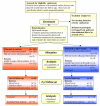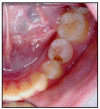The Hall Technique; a randomized controlled clinical trial of a novel method of managing carious primary molars in general dental practice: acceptability of the technique and outcomes at 23 months
- PMID: 18096042
- PMCID: PMC2265270
- DOI: 10.1186/1472-6831-7-18
The Hall Technique; a randomized controlled clinical trial of a novel method of managing carious primary molars in general dental practice: acceptability of the technique and outcomes at 23 months
Abstract
Background: Scotland has high levels of untreated dental caries in primary teeth. The Hall Technique is a simplified method of managing carious primary molars using preformed metal crowns (PMCs) cemented with no local anaesthesia, caries removal or tooth preparation. This study compared the acceptability of the Hall Technique for children, their carers, and dentists, and clinical outcomes for the technique, with conventional restorations.
Methods: General dental practice based, split mouth, randomized controlled trial (132 children, aged 3-10). General dental practitioners (GDPs, n = 17) in Tayside, Scotland (dmft 2.7) placed conventional (Control) restorations in carious primary molars, and Hall Technique PMCs on the contralateral molar (matched clinically and radiographically). Dentists ranked the degree of discomfort they felt the child experienced for each procedure; then children, their carers and dentists stated which technique they preferred. The teeth were followed up clinically and radiographically.
Results: 128 conventional restorations were placed on 132 control teeth, and 128 PMCs on 132 intervention teeth. Using a 5 point scale, 118 Hall PMCs (89%) were rated as no apparent discomfort up to mild, not significant; for Control restorations the figure was 103 (78%). Significant, unacceptable discomfort was recorded for two Hall PMCs (1.5%) and six Control restorations (4.5%). 77% of children, 83% of carers and 81% of dentists who expressed a preference, preferred the Hall technique, and this was significant (Chi square, p < 0.0001). There were 124 children (94% of the initial sample) with a minimum follow-up of 23 months. The Hall PMCs outperformed the Control restorations:a) 'Major' failures (signs and symptoms of irreversible pulpal disease): 19 Control restorations (15%); three Hall PMCs (2%) (P < 0.000);b) 'Minor' failures (loss of restoration, caries progression): 57 Control restorations (46%); six Hall PMCs (5%) (P < 0.000)c) Pain: 13 Control restorations (11%); two Hall PMCs (2%) (P = 0.003).
Conclusion: The Hall Technique was preferred to conventional restorations by the majority of children, carers and GDPs. After two years, Hall PMCs showed more favourable outcomes for pulpal health and restoration longevity than conventional restorations. The Hall Technique appears to offer an effective treatment option for carious primary molar teeth.
Trial registration number: Current Controlled Trials ISRCTN47267892 - A randomized controlled trial in primary care of a novel method of using preformed metal crowns to manage decay in primary molar teeth: the Hall technique.
Figures


















Comment in
-
The Hall technique is an effective treatment option for carious primary molar teeth.Evid Based Dent. 2008;9(2):44-5. doi: 10.1038/sj.ebd.6400579. Evid Based Dent. 2008. PMID: 18584001
References
-
- NDIP Scotland's National Dental Inspection Programme 2003 http://www.dundee.ac.uk/dhsru/publications/ndip/index.htm
-
- Macpherson LM, Pine CM, Tochel C, Burnside G, Hosey MT, Adair P. Factors influencing referral of children for dental extractions under general and local anaesthesia. Community Dent Health. 2005;22:282–288. - PubMed
LinkOut - more resources
Full Text Sources
Medical

